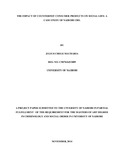| dc.description.abstract | Like in many third world countries, counterfeit and piracy has been truly a cancer to the economic development of Kenya. The counterfeit effects are seen through different social, economic and health hazards such as loss of income, environmental degradation and health damages and is part of organized crime. The study aimed to access the impacts of counterfeit on consumer products on social life, assess the level of preparedness and the ability to curb counterfeit by the law enforcement agencies. The study was conducted in Nairobi City County being the commercial hub for East and Central Africa, with a population of 3,138,369 (National Census Report, 2009, a home to major production, manufacturing and service industry in Kenya and with the largest consumers of counterfeit products thus a representative sample of the larger East Africa region. The study applied a theoretical framework based on Travis Hirshi and Michael Gottfredson‘s Self-Control Theory of Crime, Smiths’ The enterprise theory of crime to explain these phenomena. Lack of individual self esteem was linked to crime and also cases of legitimate markets not satisfying the demand and taste of many customers lead to counterfeit, that high demand for a particular good or service, low levels of risk detection and high profits created the much need conducive environment for counterfeit. Questionnaires (Quantitative) and focused group discussion (Qualitative) were used to collect data from business people, anti counterfeit agencies officials and the general users, a sample of 120 was precise and representative to obtain the result, the collected data was coded and analyzed using STATA® statistical program and conclusion and recommendations were made from the result. From the study findings, 85% of the respondents reported that counterfeit levels had increased tremendously while only 1.5% thought the level of counterfeit had remained the same while 9.7% reported reduction. (73%, p=0.534) reported encountered counterfeits at personal level compared to only 17% (p=0.946) who learned about it from the Anti-counterfeit Agency and the media. It was also reported that corruption is the major stroke towards the fight against counterfeit, corruption was highly reported in KEBS followed by police and KRA respectively. | en_US |

